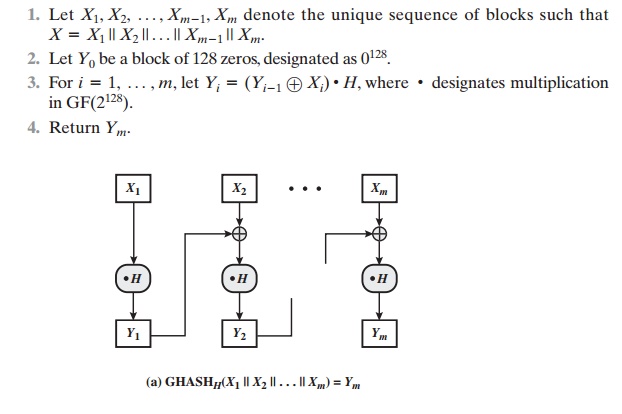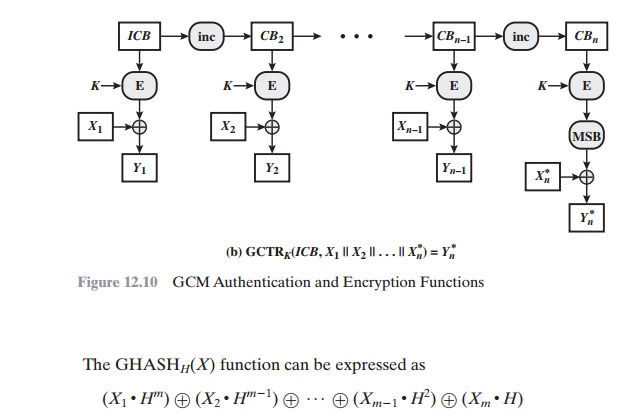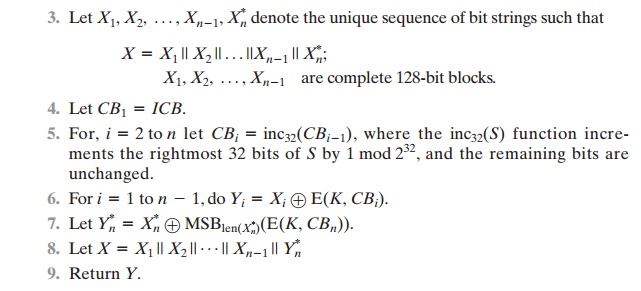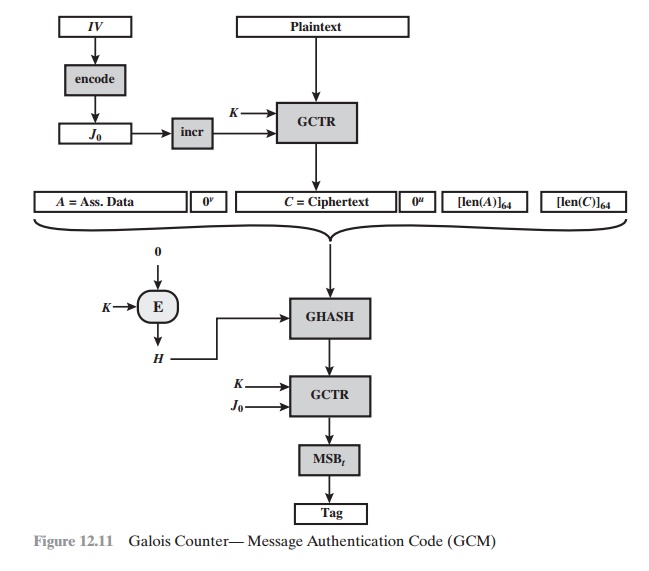Chapter: Cryptography and Network Security Principles and Practice : Cryptographic Data Integrity Algorithms : Message Authentication Codes
Authenticated Encryption: CCM and GCM
AUTHENTICATED ENCRYPTION: CCM AND GCM
Authenticated encryption (AE) is a term used to describe
encryption systems that simultaneously protect confidentiality and authenticity
(integrity) of communications. Many applications and protocols require both
forms of security, but until recently the two services have been designed
separately.
[BLAC05]
discussed four common
approaches to providing both confidential-
ity and encryption for a message M.
•
HtE: Hash-then-encrypt. First compute
the cryptographic hash
function over
M
as h = H(M). Then encrypt the message plus hash
function: E(K, (M||h)).
MtE: MAC-then-encrypt. Use two keys. First authenticate the plaintext by
computing the MAC value as T = MAC(K1, M). Then
encrypt the message plus tag: E(K2, (M || T). This approach is taken by the SSL/TLS
protocols (Chapter 16).
•
EtM: Encrypt-then-MAC. Use
two keys. First encrypt the message
to yield the ciphertext C = E(K2, M). Then authenticate the ciphertext with T
= MAC(K1, C) to yield
the pair (C, T). This approach is used in the IPsec protocol (Chapter 19).
•
E&M: Encrypt-and-MAC. Use two keys. Encrypt the message to yield the ciphertext
C = E(K2, M).
Authenticate the plaintext with T = MAC(K1, M) to yield the pair (C, T). These operations
can be performed in either order. This approach is used by the SSH protocol (Chapter
16).
Both decryption and verification are
straightforward for each approach. For HtE,
MtE, and E&M, decrypt first, then verify.
For EtM, verify first, then decrypt. There are security
vulnerabilities with all of these approaches. The HtE approach is used
in the Wired Equivalent Privacy (WEP)
protocol to protect
WiFi networks. This approach had
fundamental weaknesses and
led to the
replacement of the WEP proto-
col. [BLAC05] and [BELL00]
point out that there security concerns in each of the three encryption/MAC approaches listed above.
Nevertheless, with
proper design, any of these
approaches can provide
a high level of security. This is the goal of the two approaches discussed in this
section, both of which have
been standardized by NIST.
Counter with Cipher Block Chaining-Message Authentication
Code
The CCM mode
of operation was standardized by NIST specifically to support the security
requirements of IEEE 802.11 WiFi
wireless local area networks (Chapter 17), but can be used in any networking application requiring authenticated
encryption. CCM is a variation of the encrypt-and-MAC approach to authenticated encryption. It is defined
in NIST SP 800-38C.
The key algorithmic ingredients of CCM are
the AES encryption algorithm (Chapter 5), the CTR mode of operation (Chapter
6), and the CMAC authentica- tion algorithm (Section 12.6). A single key K is used for both encryption and MAC algorithms. The input
to the CCM encryption process
consists of three
elements.
1.
Data
that will be both authenticated and encrypted. This is the plaintext message P of
data block.
2.
Associated data A that will be authenticated but not encrypted.
An example is a protocol
header that must be transmitted in the clear for proper protocol operation
but which needs to be authenticated.
3.
A nonce N that is assigned to the payload and
the associated data. This is a unique value that is different
for every instance
during the lifetime
of a proto- col association and is intended to prevent replay attacks
and certain other types of attacks.
Figure 12.9 illustrates the operation of
CCM. For authentication, the input
includes the nonce, the associated data, and the plaintext. This input is formatted as a sequence of blocks B0 through Br. The first
block contains the nonce plus some formatting
bits that indicate the lengths of
the N, A, and P elements. This
is fol- lowed by zero or more blocks
that contain A, followed
by zero of more blocks
that contain P. The resulting sequence
of blocks serves as input to the CMAC algorithm,
which produces a MAC value with
length Tlen, which is less than or
equal to the block length (Figure
12.9a).
For encryption, a sequence of counters is generated that must be independent
of the nonce. The authentication tag is encrypted in CTR mode using the single counter Ctr0. The Tlen most
significant bits of the output
are XORed with the tag to
produce an encrypted tag. The remaining
counters are used for
the CTR mode encryption of the
plaintext (Figure 6.7). The encrypted plaintext is concatenated with the encrypted
tag to form the ciphertext output (Figure 12.9b).
SP 800-38C defines the
authentication/encryption process as follows.


For decryption and verification, the recipient requires
the following input:
the ciphertext C, the nonce N, the associated data A, the key K, and the initial counter Ctr0. The steps
are as follows.
1.
If Clen £ Tlen, then return INVALID.
2.
Apply the
counter generation function
to generate the
counter blocks
Ctr0, Ctr1, Á, Ctrm,
where m = < Clen/128 >.
3.
For
j = 0
to m, do Sj = E(K, Ctrj).
4. Set S = S1 || S2 || Á || Sm.
5.
Set P = MSBClen - Tlen(C) { MSBClen - Tlen(S).
6.
Set T = LSBTlen(C) NOR MSBTlen(S0).
7.
Apply the formatting function to
(N,
A,
P) to produce the
blocks B0, B1, Á , Br.
8.
Set Y0 = E(K, B0).
9.
For i = 1 to r, do Yi = E(K, (Bi NOR Yi - 1)).
10.
If T |=MSBTlen (Yr), then return INVALID, else return P
CCM is a relatively complex algorithm. Note
that it requires two complete passes through the plaintext, once to generate
the MAC value, and once for encryp- tion. Further, the details of the specification require a tradeoff
between the length of
the nonce and the length
of the tag, which
is an unnecessary restriction. Also
note that the encryption key is used
twice with the
CTR encryption mode:
once to generate the tag and once to encrypt the plaintext plus tag. Whether
these complexities add to the security
of the algorithm is not clear. In any case, two analyses of the algorithm
([JONS02] and [ROGA03]) conclude
that CCM provides
a high level of security.
Galois/Counter Mode
The GCM mode of operation,
standardized by NIST in NIST SP 800-38D, is designed to be
parallelizable so that it can provide high throughput with low cost and low latency.
In essence, the message is encrypted in variant of CTR mode.
The resulting ciphertext is multiplied with key material
and message length
information over GF(2128) to generate the authenticator tag. The standard also specifies a mode
of operation that supplies the MAC only, known as GMAC.
The GCM mode makes use of two functions:
GHASH, which is a keyed hash function, and GCTR, which is essentially the CTR
mode with the counters deter- mined by a simple increment by one operation.
GHASHH(X) takes
a input the hash key H and a bit string X
such that len(X) = 128m bits for some positive
integer m and produces
a 128-bit MAC value. The function may be specified as follows (Figure
12.10a).


This formulation has desirable performance implications. If the same hash key
is to be used to authenticate multiple
messages, then the values H2, H3, Á can be precalculated one time for use
with each message to be authenticated. Then, the blocks of the data to be
authenticated (X1, X2, Á , Xm) can be processed in
parallel, because the computations are independent of one another.
GCTRK(ICB,
X) takes
a input a secret key
K and a bit string X
arbitrary length and returns a ciphertext Y of
bit length len(X). The function
may be specified as follows (Figure
12.10b).
1.
If X is the empty string, then return
the empty string as Y.
2.
Let n = <(len(X)/128)>. That is, n is the smallest integer greater than or equal to len(X)/128.

Note
that the counter values can be quickly generated and that the encryption
operations can be performed in parallel.
We can
now define the overall authenticated encryption function (Figure 12.11). The
input consists of a secret key K, an initialization vector IV, a plaintext P,
and

additional
authenticated data A. The notation
[x]s means the s-bit binary
representa- tion of the
nonnegative integer x. The steps
are as follows.
1. Let
H = E(K, 0128).
2.
Define a block, J0, as
If len(IV) = 96, then let J0 = IV || 031 || 1.
If len (IV)
|=96, then let s = 128 < len(IV)/128 = - len(IV), and let
J0 = GHASHH(IV || 0s + 64 || [len(IV)]64).
3.
Let C = GCTRK(inc32(J0), P).
4. Let u = 128 <len(C)/128> - len(C) and let v = 128 <len(A)/128> - len(A).
5.
Define a block, S, as
S
= GHASHH(A || 0v ||
C || 0u || [len(A)]64 || [len(C)]64)
6.
Let T = MSBt(GCTRK1J0, S)),
where t is the supported tag length.
7.
Return (C, T).
In step 1, the hash key is generated by encrypting a block of all zeros with the secret key K. In step 2, the pre-counter block (J0)
is generated from the IV. In par- ticular, when the length of the IV
is 96 bits, then the padding
string 031 || 1 is appended to the IV to form the pre-counter block.
Otherwise, the IV is padded with
the minimum number
of 0 bits, possibly none,
so that the length of the result- ing string is a multiple of 128
bits (the block size); this string in turn is appended with 64 additional 0 bits, followed
by the 64-bit representation of the length
of the IV, and the GHASH function is
applied to the resulting string to form the
pre- counter block.
Thus, GCM is based on the CTR mode of operation and adds a MAC that authenticates both the message
and additional data that requires only authentica- tion. The function
that computes the hash uses only multiplication in a Galois
field. This choice was made because the operation of multiplication is
easy to perform within a Galois
field and is easily implemented in hardware [MCGR05].
[MCGR04]
examines the available block cipher modes of operation and shows that a CTR-based authenticated
encryption approach is the most efficient mode
of operation for high-speed packet networks. The paper further demonstrates that GCM meets a high level
of security requirements.
Related Topics